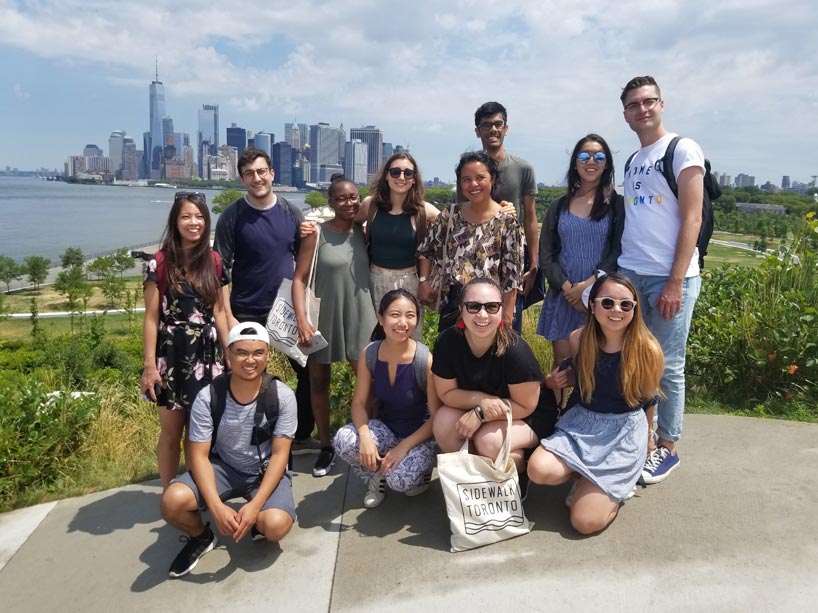A student take on city-building

In June and July 2018, a cohort of young Torontonians (including two from Ryerson) travelled the world to create recommendations for the Sidewalk Toronto waterfront community.
Creating vibrant waterfront communities has been one of Toronto’s greatest challenges—and opportunities. In summer 2018, a cohort of young Torontonians—including two from Ryerson—travelled the world to find out how other cities make their waterfronts beautiful, and what Toronto can learn.
Sidewalk Labs (external link) is working with Waterfront Toronto and the community to build a district in Toronto’s eastern waterfront. As part of the Sidewalk Toronto (external link) project, 12 students travelled to Amsterdam, Copenhagen, Malmö, Boston, New York City, and Vancouver to study how these very different cities approached their waterfronts. Their findings were published as a (PDF file) Sidewalk Toronto Fellows Report (external link) , and will be used to advise the creation of the Sidewalk Toronto district.
“I’m always having discussions with my friends about city building,” says Arnel Espanol, a 2018 Ryerson architectural science graduate, and a Sidewalk fellow. “What really interested me about this whole thing was getting to travel, and dive deep into what it really means to be an urbanist in the architecture field.”
“Just on the face of it, the idea of being able to visit these cities over the course of the summer was an amazing opportunity that I wasn’t going to get anywhere else,” says Sachin Persaud, a 2019 Master of Planning (Urban Development) candidate. “It was really relevant to my field of urban and regional planning, because I hadn’t travelled that much prior to the fellowship, so seeing how they do planning in other cities was a great opportunity.”
In Europe and North America, the students consulted with policymakers and, data scientists, urban planners, and architects, learning about new legal and technical innovations in architecture and urban planning. “It opened my eyes to what goes on behind city-building,” says Espanol. “In academia, there’s only so much that we learn about the profession of architecture. In reality, it can take a wide swath of professional expertise and community engagement to create a building let alone a city block. I think I’ve gained a higher appreciation of that through this experience.”
They also became immersed in wildly different styles of architecture and city design. Persaud fondly remembers Copenhagen, where the topography includes three rectangular lakes within the city centre. These lakes are surrounded by public trails. “They’ve done a really good job of creating public spaces along the water, creating some really great views. I distinctly remember the night we landed there, walking around Copenhagen. It was a holiday, and the streets were very empty, but it was a combination of the architecture, the sunset, and the water that made for really nice views of the city.”
The students worked in groups of two or three to create recommendations on a range of subject areas, and critiqued each other’s work. The project brought students from a variety of backgrounds and disciplines together to tackle six areas: structures and housing; mobility; public policy and governance; data; design; and public spaces and amenities.
Calling for an approach to city-building that is playful, sustainable, and people-centric, the report is not uncritical. “The Gardiner Expressway is a physical and psychological barrier along the waterfront, airplanes landing into Billy Bishop Airport disturb proximal neighbourhoods, and luxury condominiums have created a glass wall between the city and Lake Ontario,” the students write. In so doing, the students also raise their “hesitations” about the project, noting the potential conflict between public and private interests, and asking, “What will equity and inclusion look like in Quayside in practice?”
For Persaud, one of the most important challenges of the high-tech neighbourhood will be the responsible governance of data. “I think the idea of citizens being able to manage the data that they put out into the world is a powerful one. The idea of an independent body where everyone knows who sits on the trust, that would be able on a case-by-case basis to discuss requests to use this data, would be a great idea.”
For Espanol, the biggest takeaway from visiting the six cities is to have fun. “It’s been said a lot in Toronto that we don’t like to have fun when making buildings. That’s kind-of reflected in our policies here. We’re scared of trying new things. … The way other cities grow is there can be totally different from here, but as we walked and biked around through the cities, I started to realize the similarities, and how applicable a lot of what they’re doing is to Toronto.”